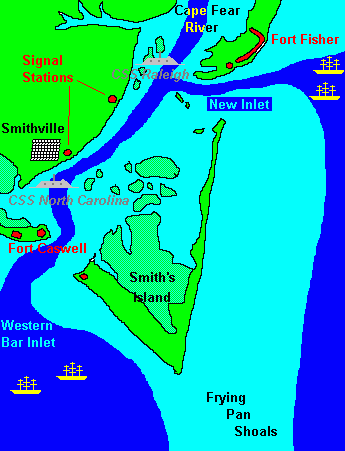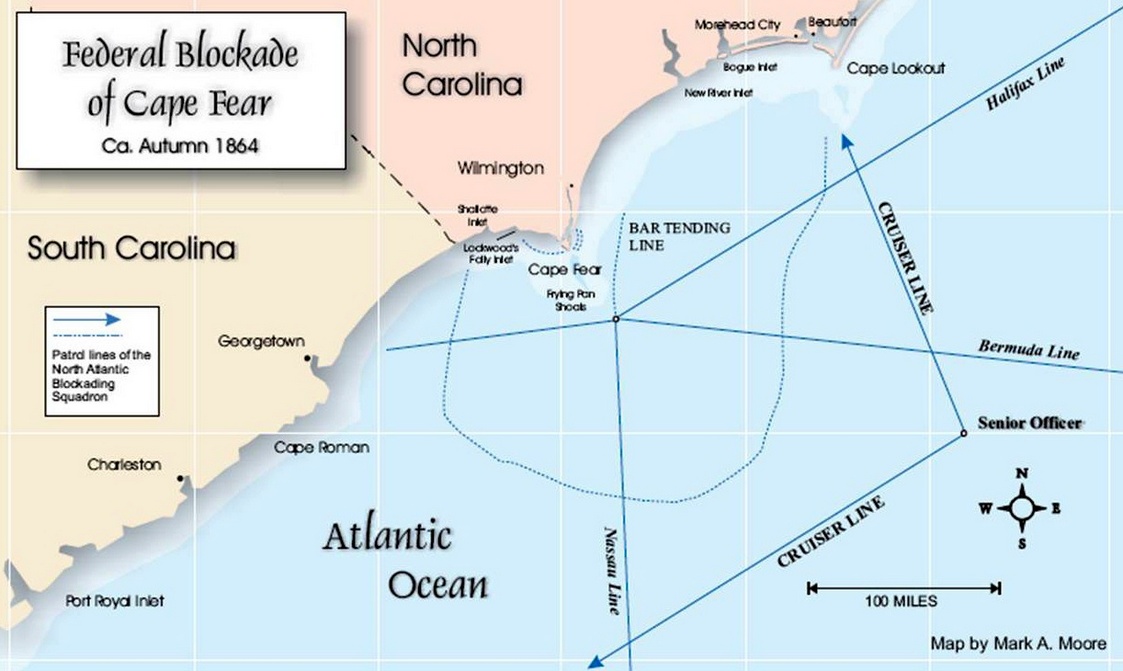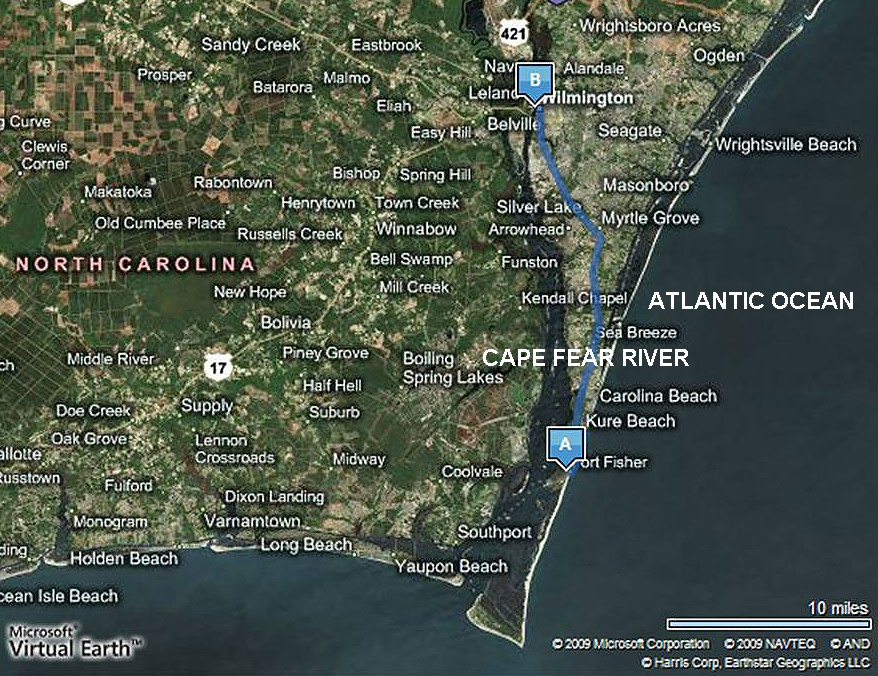|
Blockade of Wilmington, N.C.
Wilmington and the American Civil War
The Civil War Blockade of Wilmington, North Carolina
| The Blockade of Wilmington, North Carolina, Map |

|
| Courtesy Mark F. Jenkins |
The blockade of Wilmington,
North Carolina, posed a special problem for the Union Navy. Two entrances to
the Cape Fear River, Western Bar Inlet and New Inlet, are separated by Smith's Island, and extending several miles out from
Smith's Island are the Frying Pan Shoals, too shallow for blockaders to cross. Blockade runners
departing from Wilmington could descend the Cape Fear River to Smithville (present-day Southport), where signal stations communicated
with lookouts at the various forts and posts near the inlets; in this way, the blockade runners could use either inlet, whichever
one happened to be most lightly guarded at any particular time. By contrast, it took blockading vessels a few hours to travel
from one inlet to the other around Frying Pan Shoals, effectively requiring two separate blockading fleets.
The
Blockade of Wilmington, North Carolina, map reflects the Cape Fear region and its two inlets separated by Smith's
Island. The usual stations of the ironclads North Carolina and Raleigh are shown; both were lost through accidents in 1864.
This accident of geography,
coupled with the powerful Confederate works at Fort Fisher and the less powerful but still potent Fort Caswell, was in large
part responsible for Wilmington's prominence as the single most important blockade running port in the Confederacy. Rail lines
leading directly to Petersburg and Richmond
(see: Wilmington and Weldon Railroad and Siege of Petersburg) allowed military stores and other vital goods to be transported directly to General Lee's Army of Northern Virginia until
the beginning of 1865. Hence, the blockade running at Wilmington
is commonly known as "the lifeline of the Confederacy."
Two Richmond-type ironclads
guarded the approaches to Wilmington. The North Carolina spent most of her time stationed at Smithville guarding the blockade runner
anchorage there and keeping watch over the Western Bar Inlet. Her engines were weak and she did not move about much, though
on at least one occasion she is known to have ascended the Cape Fear River to Wilmington
during a dispute about the ownership of the cargo aboard the blockade runner Hansa. She would have done better to have gone
upriver into fresh water more often; her bottom was not coppered, and she sustained slow damage from teredos, salt-water marine
worms. She sprang a leak and sank on 27 September 1864 without ever having seen action.
| Union Blockade of Cape Fear Vicinity |

|
| Union Blockade of Cape Fear Vicinity |
The Raleigh,
on the other hand, attacked the blockading fleet off New Inlet in a rare evening sortie on 6 May 1864 to allow six blockade
runners to escape. After an ineffective and confusing all-night action, she returned, only to run aground on a sand bar in
the Cape Fear River and break her back. Her fate was not known to the Federal blockaders
for some time afterward, however. Despite the poor construction and the ignominious fates of the Wilmington ironclads, they served their purpose: Federal blockaders remained nervous and
on their toes, lest the Southern rams appear to wreak havoc.
The powerful Fort Fisher (named for Charles F. Fisher, a Salisbury, North Carolina, native who
had fallen at First Manassas) began as a minor battery to guard the channel leading to New Inlet. By late 1864, largely through
the efforts of Colonel William Lamb, it was perhaps the strongest earthwork in the Confederacy. Lamb and his superior, General
William Whiting, consciously modeled it after the famed Malakoff works at Sevastopol,
which had sustained tremendous punishment in the Crimean War. Typically, Fort Fisher was referred to as either “the Gibraltar of the South” or "the Gibraltar
of the West." (The Gibraltar of the West, however, was also applied rather indiscriminately
to several other fortifications throughout the Confederacy). The fort successfully repulsed a poorly-coordinated amphibious
attack on 25 December 1864, only to fall to a better-planned attack on 15 January 1865. This sounded the death knell for blockade
running at Wilmington.
| Fort Fisher (A) to Wilmington (B) Route Map |

|
| Fort Fisher (A) to Wilmington (B) Route Map. Two Strategic North Carolina Civil War Battles. |
| Blockade of Wilmington Map |

|
| Civil War Blockade of Wilmington Map |
The blockading fleets did
their best. During the war, 130 vessels were wrecked, captured, or destroyed while trying to run the blockade at Wilmington,
resulting in an estimated loss of one million cubic feet of cargo. However, blockade running remained highly profitable despite
this risk; a clerk in the Confederate War Office once commented, "About one in every four steamers is captured by the enemy.
We can afford that." During the period from 1 January 1863 to 31 October 1864, the estimated export trade of Wilmington was estimated to be well over sixty-five million dollars. Imports lagged behind
this somewhat, since the return journey to Wilmington was somewhat more hazardous than the outward trip, as the vessels attempted
to avoid both the blockading ships and the coastline itself, usually at night, generally without lights.
Under Acting Rear Admiral
S. P. Lee (a distant cousin of the Confederate general Robert E. Lee), the blockade became more sophisticated and effective.
There were three tiers of ships in the blockade; small, light draft vessels lay close in to the inlets to signal the impending
escape of a runner. Upon sighting one, a rocket was sent up (some wily blockade runner captains carried their own rockets
to send up to confuse the blockaders), but the small ship did not pursue the runner. This was left to a middle-range force
that would react to the signal and attempt to capture or sink the runner. Outside of this force was an outer patrol force
that would both watch for incoming blockade runners and also function as a safety net to attempt to capture any runners that
slipped by the middle force. But the blockade was never by any stretch of the imagination air-tight, and the port was never
sealed off until Union ships were stationed in the Cape Fear River itself after the fall of Fort Fisher.
Recommended
Reading: The Wilmington Campaign: Last Departing Rays of Hope.
Description: While prior books on the battle to capture Wilmington,
North Carolina, have focused solely on the epic struggles for Fort Fisher, in many respects this was just
the beginning of the campaign. In addition to complete coverage (with significant new information) of both battles for Fort Fisher, "The Wilmington Campaign" includes the first
detailed examination of the attack and defense of Fort Anderson. Continued below…
It also features
blow-by-blow accounts of the defense of the Sugar Loaf Line and of the operations of Federal warships on the Cape Fear River. This masterpiece
of military history proves yet again that there is still much to be learned about the American Civil War. "The Wilmington Campaign is a splendid achievement. This gripping chronicle of the five-weeks'
campaign up the Cape Fear River adds a crucial dimension to our understanding of the Confederacy's
collapse." -James McPherson, Pulitzer Prize-winning author of Battle Cry of Freedom
Recommended
Reading: Gray Phantoms of the Cape Fear : Running the Civil War Blockade. Description: After the elimination of Charleston in 1863 as a viable entry port for running the blockade, Wilmington, North
Carolina, became the major source of external supply for the Confederacy during
the Civil War. The story of blockade running on the Cape Fear River
was one of the most important factors determining the fate of the South. With detailed and thought-provoking research, author
Dawson Carr takes a comprehensive look at the men, their ships, their cargoes, and their voyages. Continued below…
In mid-1863,
the small city of Wilmington, North Carolina, literally found itself facing a difficult task: it
had to supply Robert E. Lee's army if the South was to continue the Civil War. Guns, ammunition, clothing, and food had to
be brought into the Confederacy from Europe, and Wilmington
was the last open port. Knowing this, the Union amassed a formidable blockading force off storied Cape Fear. What followed was a contest unique in the annals of
warfare. The blockade runners went unarmed, lest their crews be tried as pirates if captured. Neither did the Union fleet
wish to sink the runners, as rich prizes were the reward for captured cargoes. The battle was thus one of wits and stealth
more than blood and glory. As the Union naval presence grew stronger, the new breed of blockade runners got faster, quieter,
lower to the water, and altogether more ghostly and their crews more daring and resourceful. Today, the remains of nearly
three dozen runners lie beneath the waters of Cape Fear,
their exact whereabouts known to only a few fishermen and boaters. Built for a special mission at a brief moment in time,
they faded into history after the war. There had never been ships like the blockade runners, and their kind will never be
seen again. Gray Phantoms of the Cape
Fear tells the story
of their captains, their crews, their cargoes, their opponents, and their many unbelievable escapes. Rare photos and maps.
“This book is nothing shy of a must read.”
Recommended
Reading: The Wilmington Campaign and the Battle for Fort Fisher, by Mark A. Moore. Description:
Full campaign and battle history of the largest combined operation in U.S.
military history prior to World War II. By late 1864, Wilmington
was the last major Confederate blockade-running seaport open to the outside world. The final battle for the port city's protector--Fort Fisher--culminated
in the largest naval bombardment of the American Civil War, and one of the worst hand-to-hand engagements in four years of
bloody fighting. Continued below…
Copious illustrations,
including 54 original maps drawn by the author. Fresh new analysis on the fall of Fort Fisher, with a fascinating comparison
to Russian defenses at Sebastopol during the Crimean War. “A tour de force. Moore's Fort Fisher-Wilmington Campaign is the best publication of this
character that I have seen in more than 50 years.” -- Edwin C. Bearss, Chief Historian Emeritus, National Park Service.
Recommended
Reading: Confederate Goliath: The Battle of
Fort Fisher. From Publishers Weekly: Late in the Civil War, Wilmington,
N.C., was the sole remaining seaport supplying Lee's army at Petersburg, Va., with rations and munitions. In this dramatic
account, Gragg describes the two-phase campaign by which Union forces captured the fort that guarded Wilmington and the subsequent
occupation of the city itself--a victory that virtually doomed the Confederacy. In the initial phase in December 1864, General
Ben Butler and Admiral David Porter directed an unsuccessful amphibious assault against Fort Fisher that included the war's heaviest
artillery bombardment. Continued below…
The second
try in January '65 brought General Alfred Terry's 9000-man army against 1500 ill-equipped defenders, climaxing in a bloody
hand-to-hand struggle inside the bastion and an overwhelming Union victory. Although historians tend to downplay the event,
it was nevertheless as strategically decisive as the earlier fall of either Vicksburg or Atlanta. Gragg
has done a fine job in restoring this important campaign to public attention. Includes numerous photos.
Recommended
Reading: A History of Ironclads: The Power of Iron over Wood. Description: This
landmark book documents the dramatic history of Civil War ironclads and reveals how ironclad warships revolutionized naval
warfare. Author John V. Quarstein explores in depth the impact of ironclads during the Civil War and their colossal effect
on naval history. The Battle of Hampton Roads was one of history's greatest naval engagements. Over the course of two days
in March 1862, this Civil War conflict decided the fate of all the world's navies. It was the first battle between ironclad
warships, and the 25,000 sailors, soldiers and civilians who witnessed the battle vividly understood what history would soon
confirm: wars waged on the seas would never be the same. Continued below…
About the Author: John V. Quarstein is an award-winning author and historian. He is director
of the Virginia
War Museum in Newport News and chief historical advisor for The Mariners' Museum's new USS Monitor Center
(opened March 2007). Quarstein has authored eleven books and dozens of articles on American, military and Civil War history,
and has appeared in documentaries for PBS, BBC, The History Channel and Discovery Channel.
Recommended Reading: Lifeline
of the Confederacy: Blockade Running During the Civil War (Studies in Maritime History Series). From Library Journal: From the profusion of books about Confederate blockade
running, this one will stand out for a long time as the most complete and exhaustively researched. …Wise sets out to
provide a detailed study, giving particular attention to the blockade runners' effects on the Confederate war effort. It was,
he finds, tapping hitherto unused sources, absolutely essential, affording the South a virtual lifeline of military necessities
until the war's last days. This book covers it all: from cargoes to ship outfitting, from individuals and companies to financing
at both ends. An indispensable addition to Civil War literature.
Recommended
Reading: The Rebel Raiders: The Astonishing History of the Confederacy's Secret Navy (American Civil War). From Booklist: DeKay's modest monograph pulls together four
separate stories from the naval aspects of the American Civil War. All have been told before but never integrated as they
are here. The first story is that of James Bulloch, the Confederate agent who carefully and capably set out to have Confederate
commerce raiders built in neutral England.
Continued below...
The second is that of the anti-American attitudes of British politicians, far more extreme than conventional
histories let on, and U.S. Ambassador Charles Francis Adams' heroic fight against them. The third is a thoroughly readable
narrative of the raider Alabama and her capable, quirky captain, Raphael Semmes. The final story is about the Alabama claims--suits for damages done to the U.S.
merchant marine by Confederate raiders, which became the first successful case of international arbitration. Sound and remarkably
free of fury, DeKay's commendable effort nicely expands coverage of the naval aspects of the Civil War.
|

